

Adding confidence and transparency through a Design Authority. To achieve project quality objectives, improve delivery efficiency and optimize total cost of ownership to the enterpriseApprove designs and select standards.Control the high-level design concept and keep it focused on meeting business needsDefine and communicate a standard design process to ensure interoperability, quality control, and integration of vendor components and designsEffectively assure the technical aspects of deliveryConsider opportunities throughout the above steps, providing timely and useful information during the design process.
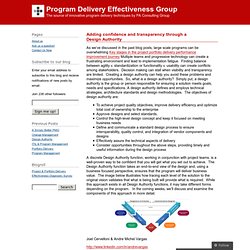
Www.improvementservice.org. Design Authority – Part two. Using the Design Authority concept in a large multi team agile environment.
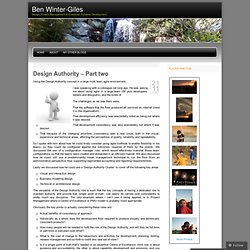
I was speaking with a colleague not long ago. He was asking me about using agile in a large team (50 plus developers, testers and designers), and the kinds of The challenges as we saw them were; That the software that the floor produced all serviced an internal client (i.e. the organisation).That development efficiency was anecdotally noted as being not where it was desired.That development consistency was also anecdotally not where it was desired.That because of the changing priorities, consistency was a real issue, both in the visual, experience and technical areas, affecting the perceptions of quality, reliability and repeatability. So I spoke with him about how he could firstly consider using agile methods to enable flexibility in his teams, so they could be configured against the outcomes required of them by the clients. Design Authority – Part one. At my presentation this year at Web Directions South I spoke briefly about the role of the Design Authority.

I’ll start this off by saying that there is in my mind, not one role that is defined by Design Authority. There are in fact three. The differentiating factor being the context and therefore your viewpoint. A Platform Thinking Approach To Problem Solving. Business is about solving customer problems.
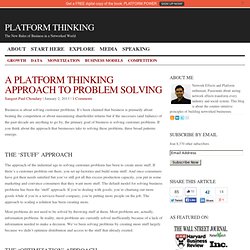
It’s been claimed that business is primarily about beating the competition or about maximizing shareholder returns but if the successes (and failures) of the past decade are anything to go by, the primary goal of business is solving customer problems. If you think about the approach that businesses take to solving these problems, three broad patterns emerge. The ‘stuff’ approach The approach of the industrial age to solving customer problems has been to create more stuff. If there’s a customer problem out there, you set up factories and build some stuff. Most problems do not need to be solved by throwing stuff at them.
The ‘optimization’ approach Enter algorithms. A Brief History of the Power of Pull - John Hagel III, John Seely Brown and Lang Davison. By John Hagel III, John Seely Brown and Lang Davison | 8:36 AM April 9, 2010 On April 13, we drop our new book — The Power of Pull: How Small Moves, Smartly Made, Can Set Big Things in Motion.

We began writing it more than a year ago, but the direct research started even further back. What Exactly is a Business Model? Everyone in the tech world talks about business models.
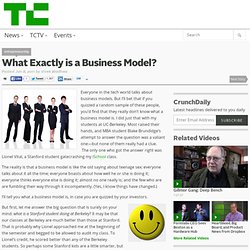
But I’ll bet that if you quizzed a random sample of these people, you’d find that they really don’t know what a business model is. I did just that with my students at UC-Berkeley. Most raised their hands, and MBA student Blake Brundidge’s attempt to answer the question was a valiant one—but none of them really had a clue.
The only one who got the answer right was Lionel Vital, a Stanford student gatecrashing my iSchool class. The reality is that a business model is like the old saying about teenage sex: everyone talks about it all the time; everyone boasts about how well he or she is doing it; everyone thinks everyone else is doing it; almost no one really is; and the few who are are fumbling their way through it incompetently. Defining Your Business Model. A business model isn't something you build from the ground up.
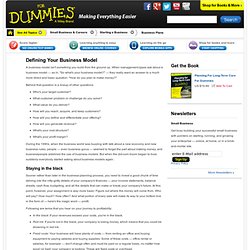
When management-types ask about a business model — as in, "So what's your business model? " — they really want an answer to a much more direct and basic question: "How do you plan to make money? " Behind that question is a lineup of other questions: Who's your target customer? What customer problem or challenge do you solve? Web 2.0. World Wide Web sites that use technology beyond the static pages of earlier Web sites A tag cloud (a typical Web 2.0 phenomenon in itself) presenting Web 2.0 themes Web 2.0 (also known as Participative (or Participatory)[1] and Social Web)[2] refers to websites that emphasize user-generated content, ease of use, participatory culture and interoperability (i.e., compatible with other products, systems, and devices) for end users.
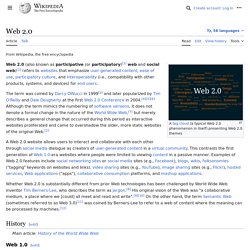
The term was invented by Darcy DiNucci in 1999 and later popularized by Tim O'Reilly and Dale Dougherty at the O'Reilly Media Web 2.0 Conference in late 2004.[3][4][5][6] The Web 2.0 framework specifies only the design and use of websites and does not place any technical demands or specifications on designers. Business model. A business model describes the rationale of how an organization creates, delivers, and captures value,[1] in economic, social, cultural or other contexts.

The process of business model construction is part of business strategy. In theory and practice, the term business model is used for a broad range of informal and formal descriptions to represent core aspects of a business, including purpose, business process, target customers, offerings, strategies, infrastructure, organizational structures, trading practices, and operational processes and policies. The literature has provided very diverse interpretations and definitions of a business model. Business models are used to describe and classify businesses, especially in an entrepreneurial setting, but they are also used by managers inside companies to explore possibilities for future development. History[edit] Over the years, business models have become much more sophisticated. Three Elements of a Successful Platform Strategy - Mark Bonchek and Sangeet Paul Choudary. By Mark Bonchek and Sangeet Paul Choudary | 11:00 AM January 31, 2013 We typically think of companies competing over products — the proverbial “build a better mousetrap.”

But in today’s networked age, competition is increasingly over platforms. Build a better platform, and you will have a decided advantage over the competition. In construction, a platform is something that lifts you up and on which others can stand. The same is true in business. Consider the market for smartphones. The use of platform thinking extends beyond the tech sector. JC Penney has made platform thinking a pillar of its reinvention strategy. Nike is also shifting from products to platforms.
The rise of platforms is being driven by three transformative technologies: cloud, social, and mobile. Readers will recognize a number of intellectual foundations to platform thinking. In our view, the success of a platform strategy is determined by three factors: